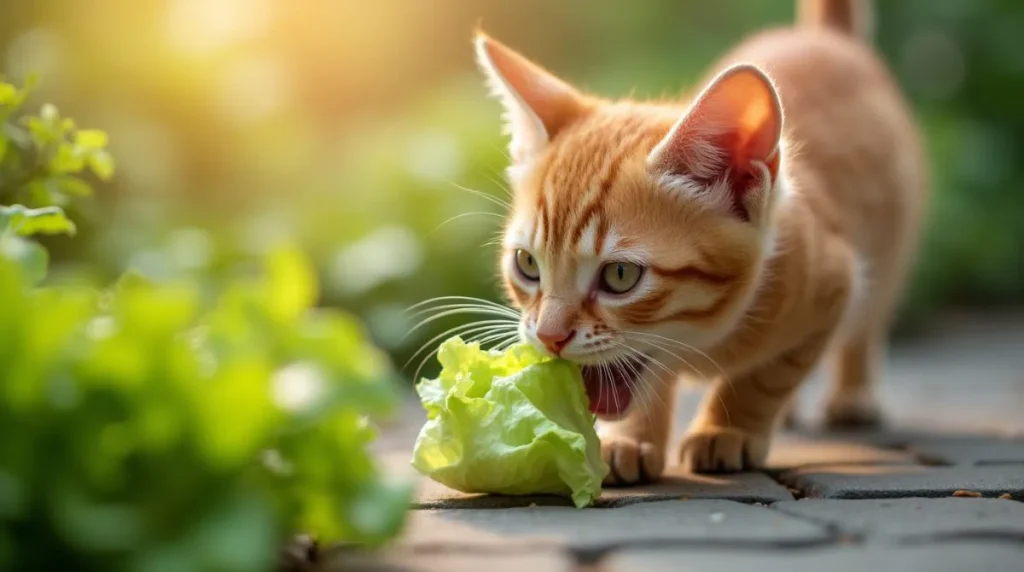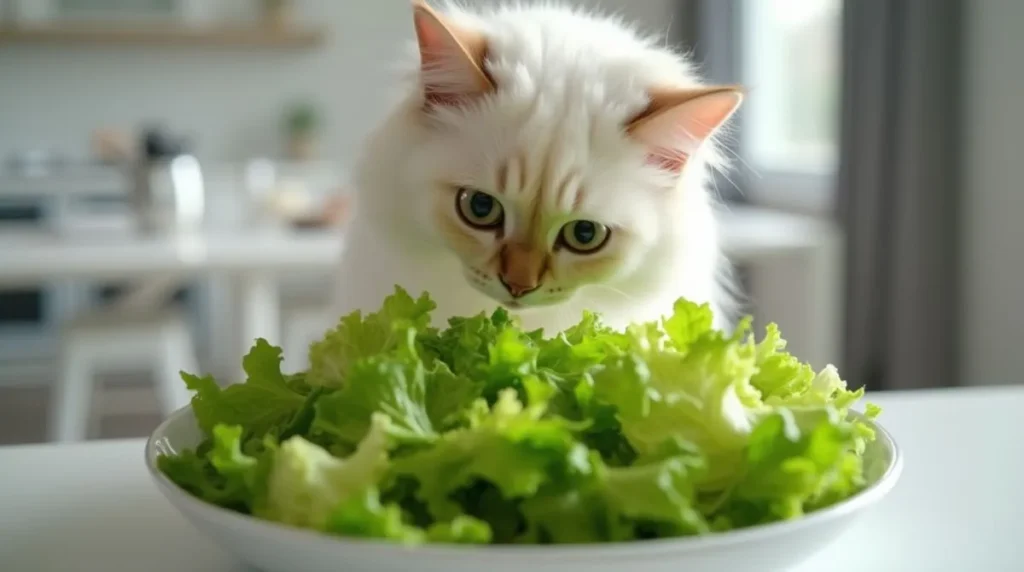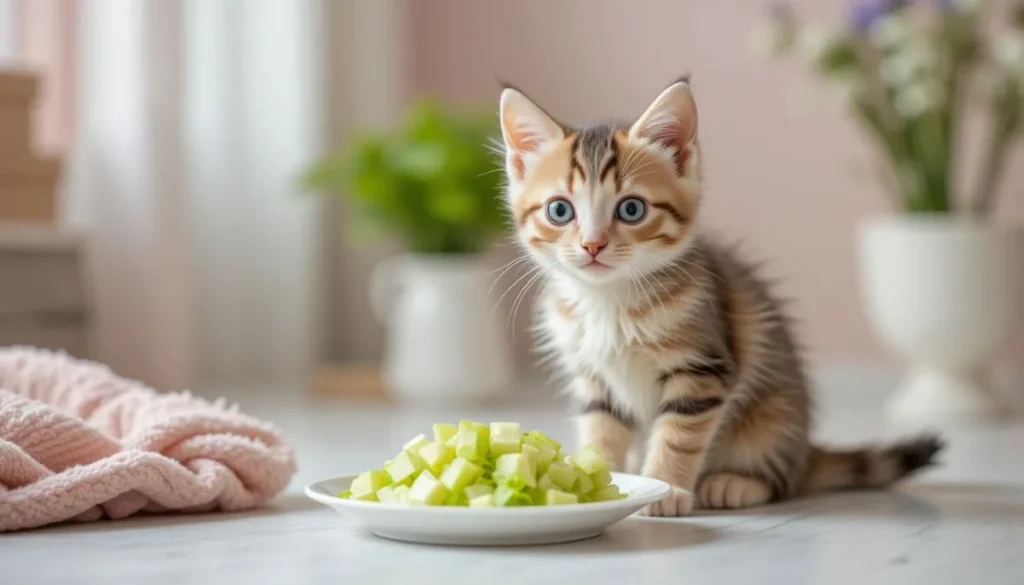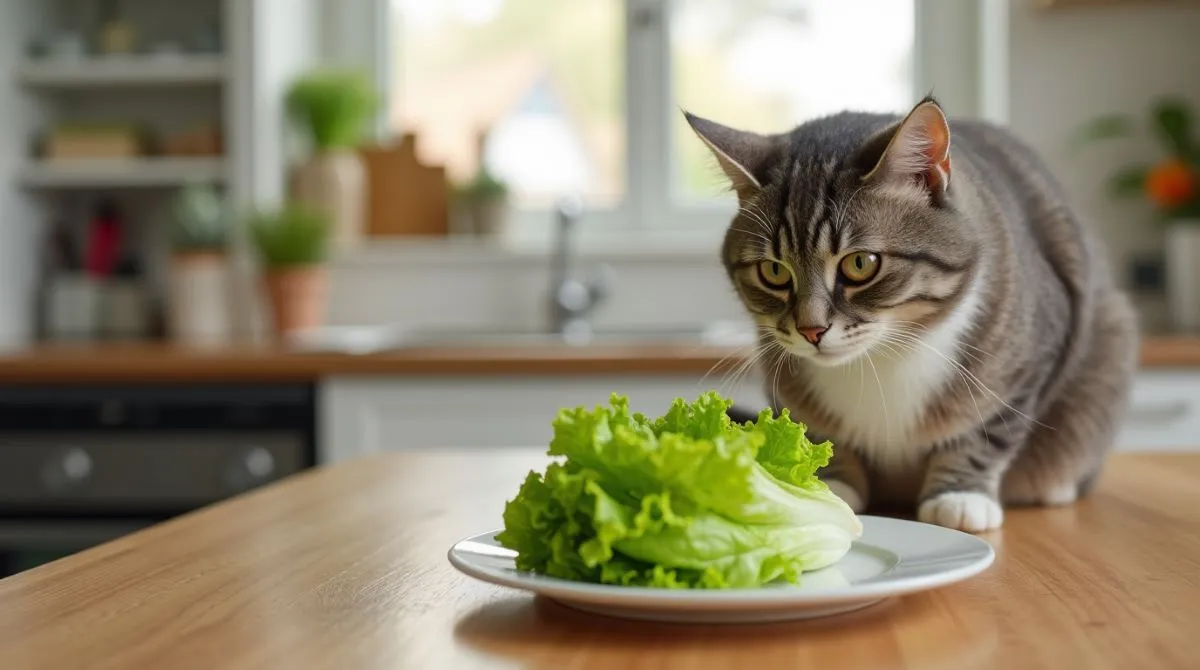When it comes to sharing food with our feline friends, many pet owners wonder about the safety of certain human foods. One common question is, “Can cats eat lettuce?” Cats are naturally curious creatures, often drawn to the crunch and texture of leafy greens. While lettuce is generally considered a safe option for cats, there are important factors to keep in mind before offering it to your furry companion.
In this guide, we’ll explore the potential benefits and risks of feeding lettuce to cats, how to prepare it safely, and 6 safe ways to feed them this crunchy treat. By the end, you’ll have a clear understanding of whether lettuce can be a healthy addition to your cat’s diet or just an occasional snack. Let’s dive in!
Table of Contents
Is Lettuce Safe for Cats?

When introducing human foods to a cat’s diet, safety is the top priority. Lettuce, a widely consumed leafy green, often sparks curiosity among pet owners. While it is generally considered safe, understanding its nutritional value, types, and potential risks is crucial before feeding it to your furry companion.
Nutritional Value of Lettuce for Cats
Lettuce is low in calories and rich in water, making it a hydrating option for humans. For cats, the nutritional benefits are minimal because they are obligate carnivores, meaning their primary nutritional needs come from meat. However, lettuce does contain trace amounts of vitamins A, C, and K, along with fiber, which can support digestion in small quantities. Despite its limited nutritional contribution, lettuce can occasionally serve as a low-calorie treat for cats.
Common Lettuce Types and Their Safety
Not all types of lettuce are created equal when it comes to cats. Varieties like romaine and green leaf lettuce are considered safe, as they are free of toxic compounds. Iceberg lettuce, on the other hand, is less suitable because it contains minimal nutrients and can cause digestive discomfort due to its high water content. Exotic varieties, such as butterhead or red leaf lettuce, may also be safe but should be introduced cautiously. Always choose fresh, pesticide-free lettuce to minimize health risks.
Possible Dangers of Giving Lettuce to Cats
While lettuce is non-toxic to cats, it is not entirely risk-free. One concern is choking, especially if large pieces are offered. Cats may struggle to chew or swallow raw lettuce effectively. Additionally, lettuce may contain pesticide residues or bacteria if not thoroughly washed, posing a health risk. Overfeeding lettuce can also lead to digestive upset, including diarrhea or vomiting, due to its high fiber and water content. Moderation is key to ensuring lettuce remains a safe snack for your pet.
Benefits of Feeding Lettuce to Cats
Lettuce may not be a staple in a cat’s diet, but it can offer a few unique benefits when served in moderation. Its high water content, fiber, and safe nutrients can make it a healthy occasional treat for your feline friend. Let’s explore the specific benefits lettuce can provide.
Hydration Benefits for Cats
Lettuce is composed of nearly 95% water, making it an excellent source of hydration. Cats, especially those on dry food diets, may not drink enough water regularly, which can lead to dehydration and urinary tract issues. Adding a small amount of lettuce to their diet can help increase their water intake naturally. This is particularly useful during warmer months or for cats prone to urinary or kidney problems.
Lettuce as a Fiber Provider
Fiber is essential for maintaining a healthy digestive system, and lettuce contains small amounts of dietary fiber that can aid in digestion. For cats experiencing minor constipation, a few shreds of lettuce can help regulate their bowel movements. However, it’s important to note that too much fiber can lead to digestive upset, so portion control is critical.
Safe Greens vs. Toxic Greens for Cats
Lettuce is a safe, non-toxic green for cats, unlike some other vegetables or plants that may be harmful. Spinach, for example, can contribute to urinary issues in cats prone to oxalate stones, while kale may lead to thyroid complications. In contrast, lettuce is mild, free of harmful compounds, and easy to digest in small quantities, making it one of the safest greens to offer your cat.
How to Prepare Lettuce for Cats
Proper preparation is key when offering lettuce to your cat. While lettuce is generally safe, taking the right steps ensures it’s clean, easy to eat, and free from harmful substances. Here’s how you can prepare lettuce safely and effectively for your feline friend.
Choosing the Right Lettuce Variety

Not all lettuce varieties are suitable for cats. Opt for nutrient-rich types like romaine or green leaf lettuce, which are safe and easier for cats to digest. Avoid iceberg lettuce, as it has little nutritional value and may cause digestive upset due to its high water content. Additionally, exotic varieties like butterhead lettuce can be introduced cautiously, but always ensure they are free from pesticides or contaminants.
Washing and Chopping for Safety
Thoroughly washing lettuce is essential to remove dirt, bacteria, and pesticide residues that could harm your cat. Rinse each leaf under running water and pat it dry with a clean towel. Once cleaned, chop the lettuce into small, manageable pieces to reduce the risk of choking. Cats are not adept at chewing leafy greens, so smaller pieces are safer and easier for them to handle.
Avoiding Additives and Dressing
When preparing lettuce for your cat, it’s crucial to keep it plain. Avoid adding dressings, oils, salt, or any other seasonings, as these can be harmful to cats. Ingredients like garlic, onion, or high-fat dressings are toxic and can lead to severe health issues. Plain lettuce, free from any additives, is the best and safest option for your pet.
6 Safe Ways to Feed Lettuce to Your Cat
Lettuce can be a fun and hydrating treat for your cat when offered correctly. To ensure your pet’s safety and enjoyment, it’s essential to serve it in ways that are both appealing and manageable. Here are six safe methods to introduce lettuce into your cat’s diet.
Small Raw Lettuce Pieces as Treats
The simplest way to feed lettuce to your cat is by offering small, raw pieces as a treat. After thoroughly washing the lettuce to remove dirt and pesticides, chop it into tiny, bite-sized portions. These small pieces are easy for cats to chew and swallow, reducing the risk of choking. Serving lettuce raw preserves its natural water content, making it a refreshing snack.
Mixing Lettuce with Regular Cat Food
If your cat is hesitant to try lettuce on its own, mixing it with their regular food can help. Chop the lettuce into fine pieces and blend it with their wet or dry food. This method ensures they consume the lettuce along with their usual diet, making it a seamless addition without overwhelming their palate.
Lettuce in Homemade Cat Treats
For a creative approach, consider incorporating lettuce into homemade cat treats. You can puree lettuce and mix it with other cat-friendly ingredients like cooked chicken or fish to create a soft, nutritious treat. Baking small portions into cat-sized snacks can make lettuce more palatable while providing variety in your cat’s diet.
Freezing Lettuce as a Hydrating Snack
During warmer months, you can freeze small pieces of lettuce for a refreshing and hydrating snack. Frozen lettuce can be a fun way to cool down your cat while keeping them entertained. Be sure to cut the lettuce into safe sizes before freezing to prevent choking hazards.
Serving Lettuce with Cat-Approved Broth

If your cat enjoys broth, you can soak small pieces of lettuce in a cat-friendly, sodium-free broth to enhance its flavor. The added taste can make the lettuce more enticing while ensuring it remains a safe and hydrating treat. Always check that the broth is free from onions, garlic, and other harmful ingredients.
Using Lettuce as a Toy or Enrichment Activity
Some cats enjoy playing with their food, and lettuce can double as an enrichment tool. Place a piece of lettuce in a treat puzzle or sprinkle it among their toys for them to discover. This approach not only stimulates their curiosity but also encourages them to try lettuce in a fun, interactive way.
Common Mistakes to Avoid When Feeding Cats Lettuce
Feeding lettuce to your cat may seem straightforward, but there are several common mistakes that pet owners should avoid to ensure their feline’s safety and health. Understanding these pitfalls can help you offer lettuce in a way that is both enjoyable and risk-free.
Overfeeding and Its Effects
One of the most common mistakes is overfeeding lettuce to cats. While lettuce is safe in small quantities, excessive amounts can cause digestive upset, including diarrhea or vomiting. Cats have a limited tolerance for fiber, and their digestive systems are not designed to process large amounts of plant matter. To avoid these issues, serve lettuce as an occasional treat and stick to small portions.
Avoiding Iceberg Lettuce
Iceberg lettuce is a popular choice for humans, but it is not ideal for cats. This variety contains very little nutritional value and is primarily composed of water. Feeding your cat iceberg lettuce can lead to bloating or loose stools without providing any real benefits. Instead, opt for nutrient-rich varieties like romaine or green leaf lettuce, which are safer and more beneficial for cats.
Failing to Wash Lettuce Thoroughly
Another critical mistake is neglecting to wash lettuce properly before feeding it to your cat. Lettuce can carry dirt, bacteria, or pesticide residues, which may pose health risks to your pet. Always rinse the lettuce under running water and dry it with a clean towel to remove any harmful substances. This step ensures that the lettuce is clean and safe for consumption.
Offering Large or Uncut Pieces
Cats are not natural chewers, and offering large or uncut pieces of lettuce can increase the risk of choking. Cats may struggle to tear or chew leafy greens effectively, leading to potential hazards. To prevent choking, always chop the lettuce into small, manageable pieces before serving it to your cat.
Using Lettuce with Additives or Dressings
Lettuce served with dressings, oils, or seasonings is unsafe for cats. Ingredients like garlic, onion, salt, and high-fat dressings can be toxic or harmful to their health. Always serve plain lettuce without any added flavors or toppings to ensure it remains a safe treat for your feline friend.

Conclusion About Can Cats Eat Lettuce?
So, can cats eat lettuce? Yes, cats can eat lettuce, but there are certain precautions you should take. Lettuce is a safe, non-toxic, and hydrating treat that can be offered to your cat in moderation. While it doesn’t provide significant nutritional value, its high water content and fiber can offer minor benefits, especially for hydration and digestion.
However, it’s essential to choose the right variety, such as romaine or green leaf lettuce, and avoid iceberg lettuce due to its lack of nutrients. Always wash the lettuce thoroughly, serve it plain, and chop it into small pieces to prevent choking.
Remember, lettuce should never replace a cat’s regular diet of protein-rich foods, as cats are obligate carnivores. Treat it as an occasional snack, and consult your veterinarian if you’re unsure about introducing new foods into your cat’s diet.
FAQ About “Can Cats Eat Lettuce?”
Can cats eat lettuce every day?
While lettuce is safe for cats, it should not be fed daily. Cats are obligate carnivores, meaning their primary nutritional needs come from animal-based proteins. Lettuce can be an occasional treat but does not provide the essential nutrients cats require for a balanced diet. Feeding it too often can also lead to digestive upset due to its high fiber content.
Is iceberg lettuce safe for cats?
Iceberg lettuce is not toxic to cats but is not the best choice. It contains minimal nutrients and is mostly water, which can lead to loose stools or bloating if consumed in large amounts. Instead, opt for romaine or green leaf lettuce, which are safer and offer slightly more nutritional value.
What are the risks of feeding lettuce to cats?
The main risks of feeding lettuce to cats include:
- Choking, especially if large pieces are served.
- Digestive upset, such as diarrhea, if overfed.
- Exposure to pesticides or bacteria if the lettuce is not washed thoroughly.
- Potential allergic reactions, though rare, which may include vomiting or skin irritation.
To minimize these risks, always serve clean, chopped, and plain lettuce in small amounts.
Why do some cats like eating lettuce?
Cats may be attracted to lettuce due to its crunchy texture, refreshing taste, or simply out of curiosity. Some cats also enjoy exploring new foods as part of their natural behavior. While cats don’t crave vegetables for nutritional reasons, occasional interest in lettuce is harmless if it’s served safely.
Can kittens eat lettuce?
Kittens can eat lettuce in very small amounts, but it’s not recommended as a regular part of their diet. Their developing bodies require high amounts of protein and fat, which lettuce does not provide. If you decide to offer lettuce to a kitten, ensure it’s finely chopped, plain, and served as a rare treat. Always consult your veterinarian before introducing new foods to a kitten’s diet.

